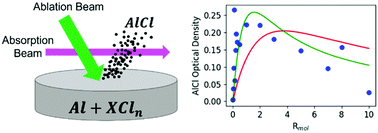Optimizing pulsed-laser ablation production of AlCl molecules for laser cooling†
Abstract
Aluminum monochloride (AlCl) has been proposed as a promising candidate for laser cooling to ultracold temperatures, and recent spectroscopy results support this prediction. It is challenging to produce large numbers of AlCl molecules because it is a highly reactive open-shell molecule and must be generated in situ. Here we show that pulsed-laser ablation of stable, non-toxic mixtures of Al with alkali or alkaline earth chlorides, denoted XCln, can provide a robust and reliable source of cold AlCl molecules. Both the chemical identity of XCln and the Al : XCln molar ratio are varied, and the yield of AlCl is monitored using absorption spectroscopy in a cryogenic gas. For KCl, the production of Al and K atoms was also monitored. We model the AlCl production in the limits of nonequilibrium recombination dominated by first-encounter events. The non-equilibrium model is in agreement with the data and also reproduces the observed trend with different XCln precursors. We find that AlCl production is limited by the solid-state densities of Al and Cl atoms and the recondensation of Al atoms in the ablation plume. We suggest future directions for optimizing the production of cold AlCl molecules using laser ablation.



 Please wait while we load your content...
Please wait while we load your content...